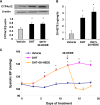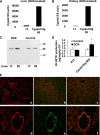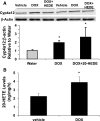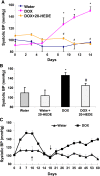Androgen-sensitive hypertension associates with upregulated vascular CYP4A12-20-HETE synthase
- PMID: 23641057
- PMCID: PMC3736709
- DOI: 10.1681/ASN.2012070714
Androgen-sensitive hypertension associates with upregulated vascular CYP4A12-20-HETE synthase
Abstract
Although the mechanism underlying the effect of androgen on BP and cardiovascular disease is not well understood, recent studies suggest that 20-hydroxy-5,8,11,14-eicosatetraenoic acid (20-HETE), a primary cytochrome P450 4 (Cyp4)-derived eicosanoid, may mediate androgen-induced hypertension. Here, treatment of normotensive mice with 5α-dihydrotestosterone increased BP and induced both Cyp4a12 expression and 20-HETE levels in preglomerular microvessels. Administration of a 20-HETE antagonist prevented and reversed the effects of dihydrotestosterone on BP. Cyp4a14(-/-) mice, which exhibit androgen-sensitive hypertension in the male mice, produced increased levels of vascular 20-HETE; furthermore, administration of a 20-HETE antagonist normalized BP. To examine whether androgen-independent increases in 20-HETE are sufficient to cause hypertension, we studied Cyp4a12-transgenic mice, which express the CYP4A12-20-HETE synthase under the control of a doxycycline-sensitive promoter. Administration of doxycycline increased BP by 40%, and administration of a 20-HETE antagonist prevented this increase. Levels of CYP4A12 and 20-HETE in preglomerular microvessels of doxycycline-treated transgenic mice approximately doubled, correlating with increased 20-HETE-dependent sensitivity to phenylephrine-mediated vasoconstriction and with decreased acetylcholine-mediated vasodilation in the renal microvasculature. We observed a similar contribution of 20-HETE to myogenic tone in the mesenteric microvasculature. Taken together, these results suggest that 20-HETE both mediates androgen-induced hypertension and can cause hypertension independent of androgen.
Figures







Similar articles
-
20-HETE and blood pressure regulation: clinical implications.Cardiol Rev. 2014 Jan-Feb;22(1):1-12. doi: 10.1097/CRD.0b013e3182961659. Cardiol Rev. 2014. PMID: 23584425 Free PMC article. Review.
-
Angiotensin II receptor blockade or deletion of vascular endothelial ACE does not prevent vascular dysfunction and remodeling in 20-HETE-dependent hypertension.Am J Physiol Regul Integr Comp Physiol. 2015 Jul 1;309(1):R71-8. doi: 10.1152/ajpregu.00039.2015. Epub 2015 Apr 29. Am J Physiol Regul Integr Comp Physiol. 2015. PMID: 25924878 Free PMC article.
-
20-HETE induces remodeling of renal resistance arteries independent of blood pressure elevation in hypertension.Am J Physiol Renal Physiol. 2013 Sep 1;305(5):F753-63. doi: 10.1152/ajprenal.00292.2013. Epub 2013 Jul 3. Am J Physiol Renal Physiol. 2013. PMID: 23825080 Free PMC article.
-
Androgen-dependent hypertension is mediated by 20-hydroxy-5,8,11,14-eicosatetraenoic acid-induced vascular dysfunction: role of inhibitor of kappaB Kinase.Hypertension. 2011 Apr;57(4):788-94. doi: 10.1161/HYPERTENSIONAHA.110.161570. Epub 2011 Feb 14. Hypertension. 2011. PMID: 21321301 Free PMC article.
-
The role of 20-HETE in androgen-mediated hypertension.Prostaglandins Other Lipid Mediat. 2011 Nov;96(1-4):45-53. doi: 10.1016/j.prostaglandins.2011.06.006. Epub 2011 Jun 22. Prostaglandins Other Lipid Mediat. 2011. PMID: 21722750 Free PMC article. Review.
Cited by
-
Epoxyeicosatrienoic Acids and 20-Hydroxyeicosatetraenoic Acid on Endothelial and Vascular Function.Adv Pharmacol. 2016;77:105-41. doi: 10.1016/bs.apha.2016.04.003. Epub 2016 May 5. Adv Pharmacol. 2016. PMID: 27451096 Free PMC article. Review.
-
20-HETE and blood pressure regulation: clinical implications.Cardiol Rev. 2014 Jan-Feb;22(1):1-12. doi: 10.1097/CRD.0b013e3182961659. Cardiol Rev. 2014. PMID: 23584425 Free PMC article. Review.
-
Effect of Cytochrome P450 Metabolites of Arachidonic Acid in Nephrology.J Am Soc Nephrol. 2017 Oct;28(10):2845-2855. doi: 10.1681/ASN.2017030252. Epub 2017 Jul 12. J Am Soc Nephrol. 2017. PMID: 28701518 Free PMC article. Review.
-
Genetic Evidence for Causal Relationships between Plasma Eicosanoid Levels and Cardiovascular Disease.Metabolites. 2024 May 23;14(6):294. doi: 10.3390/metabo14060294. Metabolites. 2024. PMID: 38921429 Free PMC article.
-
Ablation of Selenbp1 Alters Lipid Metabolism via the Pparα Pathway in Mouse Kidney.Int J Mol Sci. 2021 May 19;22(10):5334. doi: 10.3390/ijms22105334. Int J Mol Sci. 2021. PMID: 34069420 Free PMC article.
References
-
- Simpson AE: The cytochrome P450 4 (CYP4) family. Gen Pharmacol 28: 351–359, 1997 - PubMed
-
- Hardwick JP: Cytochrome P450 omega hydroxylase (CYP4) function in fatty acid metabolism and metabolic diseases. Biochem Pharmacol 75: 2263–2275, 2008 - PubMed
-
- Sacerdoti D, Escalante B, Abraham NG, McGiff JC, Levere RD, Schwartzman ML: Treatment with tin prevents the development of hypertension in spontaneously hypertensive rats. Science 243: 388–390, 1989 - PubMed
-
- Escalante B, Sacerdoti D, Davidian MM, LaniadoSchwartzman M, McGiff JC: Chronic treatment with tin normalizes blood pressure in spontaneously hypertensive rats. Hypertension 17: 776–779, 1991 - PubMed
-
- Da Silva JL, Tiefenthaler M, Park E, Escalante B, Schwartzman ML, Abraham NG: Tin mediated heme oxygenase gene activation and cytochrome P450 arachidonate hydroxylase inhibition in spontaneously hypertensive rats. Am J Med Sci 307: 173–181, 1994 - PubMed
Publication types
MeSH terms
Substances
Grants and funding
LinkOut - more resources
Full Text Sources
Other Literature Sources
Medical
Molecular Biology Databases

